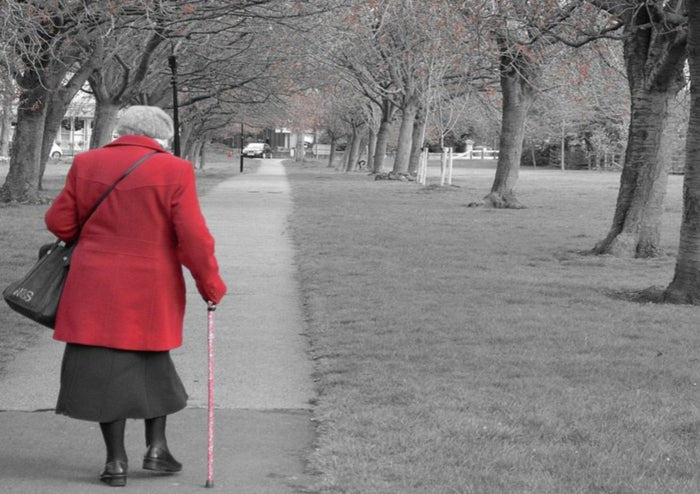HOW THE RIGHT ORTHOTICS CAN IMPROVE SENIOR MOBILITY

As we get older, our mobility diminishes due to numerous factors. Some of the first visible signs of aging may be changes to posture and gait, as well as fatigue and general weakness doing everyday tasks. People may notice an impact on mobility when engaging in activities such as walking. Aging affects muscle mass and strength, bone density, and can make joints stiffer and less flexible due to reduction of cartilage thickness1 (Nestle Health Science).
Why Senior Mobility Matters
Immobility is one of the most common age-related disabilities. In a report based on 2008-2012 U.S. Census results, it was determined that 2 out of 3 Americans age 65 and older struggle with walking and/or climbing. With the inability to walk, climb, or move at all comes several serious issues including:
- Depression
- Isolation
- Fall-related injuries
- Inability to reach phone or door to seek help or assistance
The monetary cost of an immobile loved one can mount quickly. Medical devices like powered scooters and lifts, assisted living care, security monitoring, transportation, and medical bills from injuries related to falls can put additional strain on both the elderly individual and their family. That’s why it’s best to address mobility issues as early as possible. What starts as “a little trouble getting up” quickly becomes a bigger issue requiring special equipment to aid movement including:
- Walking Cane
- Walker
- Wheelchair
- Scooter / Powered Wheelchair
Always Wear Proper Foot Gear
Foot health is vitally important to mobility and independence as we age, and wearing the right orthotics can help us stay more active and self-reliant. Wearing appropriate footwear can help improve balance, especially in older people who may struggle with mobility and balance issues. This is a 24 hour / 7 day rule, whether out running errands or at home cooking dinner. The right footwear can support and strengthen your foot and arch, in turn enhancing overall balance and mobility.
When selecting a shoe to improve balance, always press on both sides of the heel area to ensure the heel is stiff and won't collapse. Also, bend the shoe to check for toe flexibility. The shoe shouldn't bend too much in the toe box area, but it shouldn't be too stiff and inflexible either. Finally, try the twist test to ensure it doesn’t twist in the middle.
Natural aging and health changes can cause foot size to change, so it’s important to have your feet professionally measured every time you purchase shoes. Measure both feet—late in the day—and shop for the larger foot. Another good tip is to bring the type of socks you plan to wear and walk around with them in the shoes before purchasing.
Shoes should feel comfortable and supportive right away. If they don't, breaking them in won't improve things. Often shoes can be complimented with the used of orthotic inserts to provide additional support and mobility to the foot, as well as additional comfort the shoe may lack. Common indications that foot orthotics are necessary for balance include: muscle weakness, fallen arches, ataxia, gait abnormality, joint instability, difficulty walking, peripheral neuropathy, limb pain, arthropathy and hemiplegia. Using a good supportive orthotic insert for these conditions will contribute to helping reduce the risk of falls and aid in the mobility of Seniors (Podiatry Today).
Additional Ways to Improve Mobility in the Elderly
Now that you’re aware of the seriousness of mobility and how orthotics can help address those issues, noted are a few more ways to stave off immobility.
- Exercise & Stay Active: The best defense is a good offense; this applies to many things in life, including enhanced mobility. The more stationary your life becomes, the harder it will be to remain mobile.
- Using the stairs regularly
- Parking further away from your destination for a quick walk
- Walking to nearby shops or neighbor’s homes instead of driving
- Only utilizing a medical transport device (i.e. scooter, wheelchair) at the direction of a doctor or physical therapist
- Maintain a Healthy Weight: Mobility depends on having strong legs. Certain conditions like obesity can weaken your legs to the point of immobility. That’s why maintaining a healthy weight is essential for continued mobility during elderly years.
- Stretch Regularly: People of all ages should stretch regularly for better bodily function, decreased pain, increased blood flow, and enhanced mobility. If you’re looking at the easiest way to improve mobility in elderly, stretching is it.
Now is the time to make sure that enhancing your mobility is facilitated with proper arch support, and you can do that for your feet with SelectFlex Arch Control Insoles. This allows for optimal support, MOBILITY and comfort with every step that you take. Along with good routine foot care, you can significantly reduce your risk of serious slips, trips and falls. Take control of your Foot care today! Find out more about this special Arch-Control Insole.
FOLLOW US






